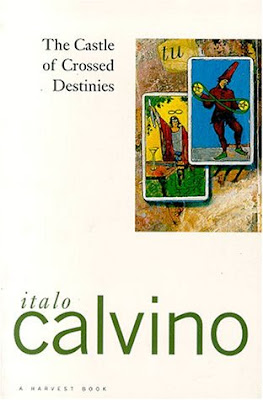translated by William Weaver
Harcourt Brace
1969 and 1973, reprinted 1976
The Castle of Crossed Destinies is like Italo Calvino's Canterbury Tales or his Decameron, although unfortunately, I only mean that in terms of form and content, not quality. This is not Calvino's best work.
Calvino is known for using gimmicks and tricks to provide structure to his work, and then to tell stories within the lattice his rules have established. In this case, he takes a deck of tarot cards, lays them out in a grid, then tries to come up with sensible stories by following one card to the next, up and down the columns, and across the rows.
In fact, he performs this party trick twice, once using an Italian tarot deck as his inspiration, and then again using a French deck with different art. (I believe that these two novellas were originally published separately; in English they only appear in a combined edition.) His second attempt is notably better than the first.
So, the conceit here is that Calvino and other storytellers are in a castle or tavern, they are all rendered mute, and they take turns telling their stories by laying out the tarot cards. Calvino interprets what they must mean, and we are led to believe that everyone in the castle has the same interpretive experience and achieves the same understanding. Then, once the grid is finished, Calvino looks at the completed layout and sees other possible stories.
Also, the interpretations are supposed to be based less on the traditional symbolic meaning of the card and more on its specific artistic rendering. Aiding this process is the fact that on each page, images of the cards mentioned on that page are reproduced in the side margin. It both makes the book visually very interesting to look at, and being able to see the cards he's describing definitely enhances the reading experience. Once the full tarot grid is assembled, that's reproduced too, once for each version. This is what the French tarot grid looks like:
Calvino is known for using gimmicks and tricks to provide structure to his work, and then to tell stories within the lattice his rules have established. In this case, he takes a deck of tarot cards, lays them out in a grid, then tries to come up with sensible stories by following one card to the next, up and down the columns, and across the rows.
In fact, he performs this party trick twice, once using an Italian tarot deck as his inspiration, and then again using a French deck with different art. (I believe that these two novellas were originally published separately; in English they only appear in a combined edition.) His second attempt is notably better than the first.
So, the conceit here is that Calvino and other storytellers are in a castle or tavern, they are all rendered mute, and they take turns telling their stories by laying out the tarot cards. Calvino interprets what they must mean, and we are led to believe that everyone in the castle has the same interpretive experience and achieves the same understanding. Then, once the grid is finished, Calvino looks at the completed layout and sees other possible stories.
Also, the interpretations are supposed to be based less on the traditional symbolic meaning of the card and more on its specific artistic rendering. Aiding this process is the fact that on each page, images of the cards mentioned on that page are reproduced in the side margin. It both makes the book visually very interesting to look at, and being able to see the cards he's describing definitely enhances the reading experience. Once the full tarot grid is assembled, that's reproduced too, once for each version. This is what the French tarot grid looks like:
In the first version, Calvino spends so much time explaining how he slowly, haltingly, confusedly moves from looking at the card art and watching the storytellers' facial expressions and body language to arriving at a narrative that the stories are overwhelmed by his imaginary translation of their telling. In the second version, he still points to specifics in the art a lot, but gets out of his own way a bit more, which helps a lot.
The images on tarot cards are meant to be archetypal, and Calvino's stories all feature archetypal medieval characters - though the plots tend to go off the rails compared to the originals, and they often end in chaos, either with an apocalyptic disaster, or else with several stories converging until it seems like every character is the same character and every tale is the same tale.
So we get a lot of knights and queens, nuns and alchemists, Faust and Parsifal, Hamlet, Merlin, the paladin Roland. Angelic women, Death, and the Devil all show up repeatedly. We don't get much in the way of characterization or interiority. What the cards produce are characters and events, not really motive or psychology. Whenever Calvino stops narrating the translation process, the plots can move at a breakneck pace.
As a thought experiment, this is interesting. As a work of fiction, I don't think it's particularly successful. Calvino's playfulness, his allusions to classic literature, and his subversion of traditional story endings are all kind of fun, but for me, they were outweighed by the belabored way he showed his work of moving from card to text.


No comments:
Post a Comment